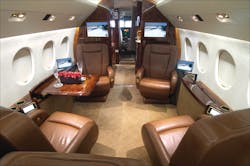Exotic Interiors Help Boost Refurb Market, Pose Challenges
Today’s bizjets aren’t your father’s flying machines, inside or out. The private jet interior refurbishment market is hot right now. Supplying the sizzle is an array of exotic cabin designs favored by flyers who want their airborne accommodations to mimic their ground-bound home or automobile.
Business or personal jet owners “are people that have demanding expectations,” says Jarod Triplett, vice president of business development for Davis Junction, Illinois-based services supplier and certification testing firm Skandia. “They want to have some uniformity [among] the designs of their homes, their exotic cars, and their private jet.”
Debi Cunningham couldn’t concur more. Over the past six to eight months the vice president of marketing and interior design for East Alton, IL-based MRO West Star Aviation says customers have been craving seat stylings “just like they have in their cars – Ferraris, Maseratis. We’ve [even] had a couple of Bentley requests.”
“In regards to aesthetics, you’re seeing a direct link to the automotive industry,” agrees Veta Traxler, paint and interior lead designer at Moline-headquartered Elliott Aviation. That automobile affinity plays out in seat perforations, piping, colors, forms, and shapes.
This airborne affinity for automobile interiors isn’t the only reason for the surge in seat and interiors work MROs are handling, but it helps.
“It’s crazy how busy we are,” says West Star’s Emilie Harbour, the company’s paint and interior design lead. “How much we have going on at a time truly reflects how many people are wanting to have their cabin refurbished. Everyone wants something that is nice, trendy, and up-and-coming.” Cunningham calculates West Star’s interiors growth over the past half-dozen years at some 20 percent per annum.
Custom work dominates at both West Star and Elliott. “We have never really had a ‘plug ‘n play’ [standardized] type of interior,” says Cunningham. “Probably 85 percent of our interiors are custom.” Elliott’s work too is predominately custom. The price tag for interiors on aircraft such as a Falcon 2000 or Gulfstream can run “upwards of 500-hundred-thousand to a million dollars,” she says, when you figure in Wi-Fi, Sat-Com, and entertainment systems.
More and more private jet owners want the latest IFE, the better to complement cutting-edge cabin furnishings. “They’re asking for very, very large [TV] monitors” too, says Harbour. One customer wanted a 32-inch affair for their aircraft, one that “will literally stow on the bulkhead then [deploy] to cover the bulkhead and part of the lavatory door.” Others are interested in sophisticated Alto audio systems.
Everyone demands airborne Wi-Fi and in-seat powerports so they can power up their PCs, iPods, IPads, or other devices.
Challenges
For customers so acutely attuned to fashion, one challenge is getting the aesthetics right. A customer might love their Ferrari seat. But it’s not perfectly transferable – in material composition or look and feel – to a Challenger. “It’s going to be a lot more difficult to get that sleek car look out of their [airplane] seat,” says Harbour. That’s because you’ve got to build up the foam, and fit the seat upholstery on the aircraft’s certified seat frame.
Skandia’s Triplett believes the advent of car-like seats and accoutrements focuses the whole interiors’ process squarely on flammability testing and certification. Making the job easier is that “95 percent” of all private jet seat innards are formed from fire-retardant, graphite-impregnated DAX foam. To test the fire-blocking capabilities of a seat, Triplett says Skandia subjects a test specimen to an 18-inch flame at some 1,830 F for two minutes, all with the aim of ensuring it doesn’t shed more than 10 percent of its mass. He says employing tried-and-true DAX foam “provides [designers] the opportunity to get a little bit more aggressive in the upholstery process.”
The importance of preplanning
Another challenge is timing. Don’t just show up at the hangar door with your jet unannounced. Meticulous preplanning of the work package, on the part of customer and interior shop alike, is critical.
“The earlier we can start working with the customer before the aircraft [comes] into the door, [the better] it is for the customer,” says Cunningham. Lead-time is the latchkey. “If a customer gives us a month to preplan, we can cut probably two to four weeks off [the delivery date] of the final product. That allows the interior shop to work out the complex choreography of material, manpower and space required to do the job.
Traxler too says lead-time is imperative. “The more you have preplanned [the better].
Even then, West Star says a large interior/in-flight entertainment (IFE) project can take 12 to 16 weeks to complete. Cunningham says 60 to 70 percent of the time large interior/IFE work packages are done during the same shop visit as heavy checks, inspections, or major engine work. That cuts downtime for the customer’s expensive airborne asset.
Size matters in any business, not the least aircraft interiors. Interestingly, the larger the tubular palate (the fuselage) the easier, some contend, the job is. It’s when you start working the smaller airframes that things can get interesting.
“[Our] biggest challenge is that we’re working in a smaller area,” says Elliott Aviation’s Traxler. She says customers must keep in mind that “you’re designing for a tube, and not a room.” Some patterns, some designs don’t necessarily work well in tighter spaces.
To give customers a 3-D preview of what the cabin of their, say, Hawker 800 or King Air 350 will look like Elliott is developing software allowing customers to change the color of the seat, re-work the woodwork, change up the headliner, sidewall fabrics, and such. “You can [even] ‘walk’ up and down the airplane and change the stitch pattern,” says Traxler.
Attracting and hanging on to artisans
All this work, of course, takes the proper people. If you think recruitment and retention is a problem in the sheet metal and powerplant precincts of the MRO business, squeeze into the shoes of the interior shop folks and see how tight things are.
In mid-2014 Cunningham had a chat with West Star’s East Alton interiors manager. The shop employs some 75 to 80 folks. He told her he could use 15 more people right then – if he could find them. Such is the workload.
Cunningham says West Star finds its interiors people in the ranks of those already employed in the industry. That task is “becoming very difficult.” As for recruiting newly minted trade school grads, the influence of the automotive industry impacts aircraft interiors in another way too. “A lot of time [would-be workers] are being hired by … BMW or Mercedes.”
Make no mistake about woodworking, seat stitching, and sidewall installation: All are the province not of mere tradesmen, but of craftsmen.
Elliott Aviation faces the same problem. “It’s very hard to find and retain good, qualified craftsmen,” says Traxler, “especially when we’re doing modifications to cabinets [and] sewing up different seat patterns” often from scratch.
Elliott does a lot of trade school recruiting and conducts tours of its facility for local high school students in an effort to fill the gap.
There may be a labor gap just now, but there’s precious little space between a customer’s desires and what interior artisans can render. “They want to see everything customized to their liking,” reiterates Cunningham. “When they come to visit [the shop] they want a show.”




